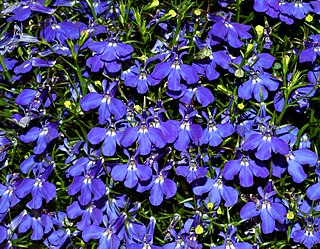
Lobelia is a genus of flowering plants in the family Campanulaceae comprising 415 species, with a subcosmopolitan distribution primarily in tropical to warm temperate regions of the world, a few species extending into cooler temperate regions. They are known generally as lobelias.

The family Campanulaceae, of the order Asterales, contains nearly 2400 species in 84 genera of herbaceous plants, shrubs, and rarely small trees, often with milky sap. Among them are several familiar garden plants belonging to the genera Campanula (bellflower), Lobelia, and Platycodon (balloonflower). Campanula rapunculus and Codonopsis lanceolata are eaten as vegetables. Lobelia inflata, L. siphilitica and L. tupa and others have been used as medicinal plants. Campanula rapunculoides may be a troublesome weed, particularly in gardens, while Legousia spp. may occur in arable fields.

Professor David John Mabberley, is a British-born botanist, educator and writer. Among his varied scientific interests is the taxonomy of tropical plants, especially trees of the families Labiatae, Meliaceae and Rutaceae. He is perhaps best known for his plant dictionary The plant-book. A portable dictionary of the vascular plants. The third edition was published in 2008 as Mabberley's Plant-book, for which he was awarded the Engler Medal in Silver in 2009. As of June 2017 Mabberley's Plant-book is in its fourth edition.

Lobelia cardinalis, the cardinal flower, is a species of flowering plant in the bellflower family Campanulaceae native to the Americas, from southeastern Canada south through the eastern and southwestern United States, Mexico and Central America to northern Colombia.

Isotoma is a genus of annual and perennial herbs in the family Campanulaceae and are native to Australia and New Zealand.

Lobelia scaevolifolia is a species of the plant family Campanulaceae. It is endemic to the island of Saint Helena in the South Atlantic Ocean. It was at one time placed as the only species, Trimeris scaevolifolia, in the genus Trimeris. Its common name is St. Helena lobelia.
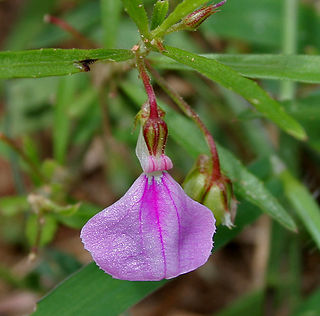
Hybanthus (green-violet) is a genus of flowering plants in the family Violaceae. This genus name is Greek for "humpback flower", referring to the drooping pedicels of plants that are part of this genus. The genus is grossly polyphyletic and may contain up to nine different genera, of which Pombalia Vand., Cubelium Raf. and Pigea DC. have been previously recognised.

Pratia is a formerly recognized genus of flowering plants in the family Campanulaceae, native to Asia, Australia and New Zealand. Along with other genera, such as Hypsela and Isotoma, it is now included in Lobelia.

Lobelia purpurascens, commonly known as white root or purplish pratia, is a flowering plant in the family Campanulaceae of eastern Australia. It is a small herbaceous, scrambling plant with white to pale pink flowers.

Lobelia pedunculata, commonly known as matted pratia, trailing pratia or blue star creeper, is a perennial herb from Australia.

Lobelia anceps, commonly known as angled lobelia, is a small herbaceous plant in the family Campanulaceae it grows in several states of Australia, New Zealand, South America and South Africa. It is a small, perennial herb with blue to purple flowers.

Scaevola plumieri is a species of plant in the family Goodeniaceae which grows on coastal dunes in the tropics and subtropics.
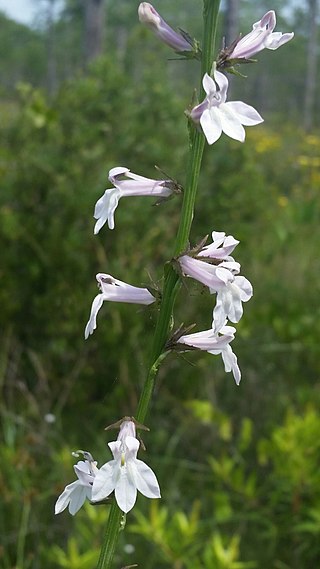
Lobelia floridana, commonly known as Florida lobelia, is a species of flowering plant in the bellflower family (Campanulaceae) native the southeastern United States. It was first formally named in 1878 by Alvan Wentworth Chapman.
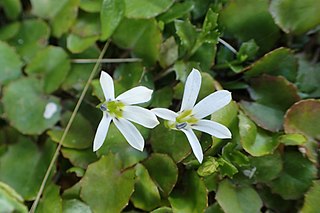
Lobelia angulata, previously known as Pratia angulata, and commonly known as pānakenake, is a small herbaceous scrambling herb native to New Zealand.
Lobelia georgiana, the Georgia lobelia, is a species of flowering plant in the family Campanulaceae, native to the southeastern United States. It is likely that the range of Lobelia georgiana only extends to Alabama, Georgia and Florida due to misidentification of specimens.

Lobelia polyphylla, called the tabaco del Diablo, is a species of flowering plant in the family Campanulaceae, native to northern and central Chile. When smoked, it has narcotic and hallucinogenic effects.

Lobelia trigonocaulis, the forest lobelia is a creeping or trailing herb, found in moist forest areas in New South Wales and Queensland in Australia. Blue to mauve flowers form between the months of December and May. Leaves are near circular or ovate in shape; ranging from about 4.0 to 5.5 cm long and 2.5 to 3.8 cm wide.

Symphyotrichum concolor is a species of flowering plant in the family Asteraceae native to the Atlantic coastal plain and Piedmont areas of the eastern United States, as well as the Bahamas. Commonly known as eastern silvery aster, it is a perennial, herbaceous plant that may reach 30 to 80 centimeters in height. Leaves are a grayish-green and have a silky look and feel. The flowers have 8–12 rose-purple, rarely white, ray florets, and pink then purple disk florets.

Lobelia browniana is a species of flowering plant in the family Campanulaceae and is endemic to eastern Australia. It is an erect, glabrous, annual plant with narrow leaves and one-sided racemes of blue flowers with long, soft hairs in the centre.
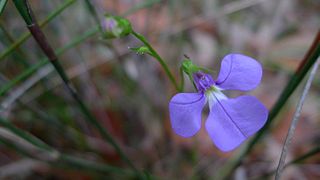
Lobelia anceps, commonly known as trailing lobelia, is a small herbaceous, flowering plant in the family Campanulaceae. It has dark blue or purple flowers and grows in New South Wales and Queensland.



















